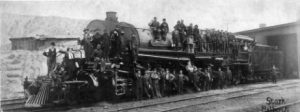MIDVALE WAS HOME TO A VIBRANT SOUTH SLAV COMMUNITY
Miriam B. Murphy
History Blazer, August 1995

Ca. 1980-1910 Croats, Slovenes, and Serbs at Denver and Rio Grande Western Railroad Company
As early as 1890 Serbs, Croats, and Slovenes began arriving in the Midvale-Murray area seeking work in the smelters. Many of them came to stay after the turn of the century, in part because of poor agricultural conditions in the Old Country and labor strife in the industrial areas of the eastern U.S. In 1904 the three smelters in Midvale (called Bingham Junction then) were operated by U. S. Smelting, Refining, and Mining Company, American Smelting and Refining Company, and Bingham Consolidated Mining and Smelting Company. Most of the South Slav immigrants found work at ASARCO’s Midvale smelter. Many of them were young single men who lived in boardinghouses or with married countrymen. According to historian Joseph Stipanovich, the typical boardinghouse in Midvale was operated by a South Slav couple who provided each worker with a place to sleep, laundry service, and meals—including lunch—for a monthly charge. Workers often slept and ate in shifts as space in the boardinghouse was minimal. That placed a great burden on the housewife, who often had small children to care for in addition to several dozen boarders. As one woman lamented, “It was horrible awful….I had to carry all the water from a long way….Wash and cook on coal stove and eat in two or three shifts. That was hell…woman was slave.”
Because Midvale was a community still under construction when its immigrant population began to arrive, boardinghouses and private homes were dispersed throughout the town rather than concentrated in certain areas. One social institution that quickly followed the arrival of South Slavs was a modified version of the Old Country saloon or inn. Called biltiya in Croatia, they served in America as an information center for new arrivals as well as a place to talk politics, dance, gamble, and eat and drink. Unlike the Old Country biltiya, geared to the needs of peasant farmers, the Midvale version operated from morning to night to accommodate shift workers. It also provided a haven where a familiar language was spoken and where newcomers could find help with everything from reading and writing letters to coping with strange American customs.
Before long the South Slavs, like other immigrant groups, established organizations. In 1908, for example, Croats in Midvale started a lodge affiliated with the Croatian Fraternal Union while Serbs organized the independent Serbian Benevolent Society. A major goal of such organizations was to provide life insurance. Given the hazardous working conditions in that era, providing for one’s survivors was an important consideration. Of course, the fraternal lodges also allowed men to gather in a more respectable setting than the saloon. The Roman Catholic Croats found their religious needs taken care of by churches already established in the valley. But the Orthodox Serbs began a building fund for a Serbian Orthodox church that was completed in 1918.
Easter and Christmas were occasions for community celebrations that featured barbecued lamb or roast pig. Eating, drinking, singing, and dancing continued until late in the evening. “At Christmas, the Croats and Slovenes would celebrate on December 25 and they would invite the Serbs to join them. On January 7 the Serbs would celebrate Orthodox Christmas…and invite the Croats and Slovenes to join in their celebrations.”
South Slav immigrants settled in other parts of Utah: most notably Highland Boy in Bingham Canyon and Helper in Carbon County, but, according to Stipanovich, their “settlement at Midvale was a remarkable one in several ways. First, it was developed in a relatively ordered fashion with much less social dislocation and cultural disorientation….Second, the South Slavs were able to establish organizations which eased their process of transition to American life without any major difficulties with their neighbors. Third, it served as a place of arrival and dispersal for many of the South Slavs who came to northern Utah. This was because it was one of the oldest, largest, and the most centrally located of all the South Slav settlements.”
See Joseph Stipanovich, The South Slavs in Utah: A Social History (San Francisco: R and E Research Associates, 1975).